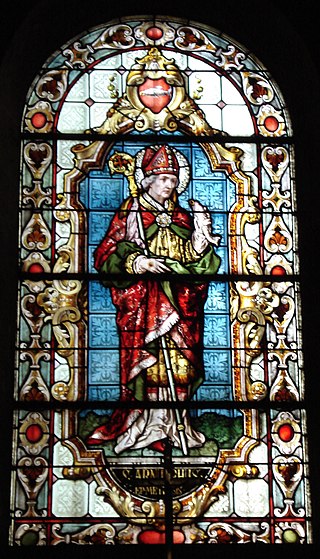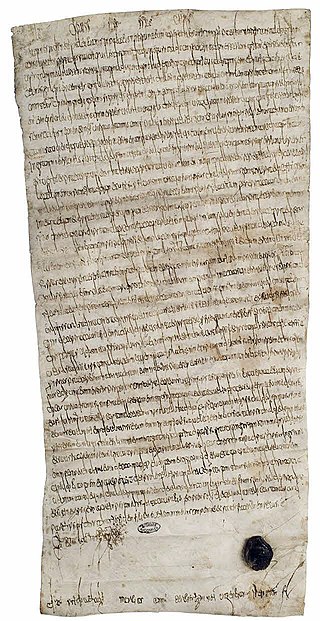
Pepin Iof Landen, also called the Elder or the Old, was the Mayor of the palace of Austrasia under the Merovingian King Dagobert I from 623 to 629. He was also the Mayor for Sigebert III from 639 until his death.

Pepin II, commonly known as Pepin of Herstal, was a Frankish statesman and military leader who de facto ruled Francia as the Mayor of the Palace from 680 until his death. He took the title Duke and Prince of the Franks upon his conquest of all the Frankish realms.

Austrasia was the northeastern kingdom within the core of the Frankish empire during the Early Middle Ages, centring on the Meuse, Middle Rhine and the Moselle rivers. It included the original Frankish-ruled territories within what had been the northernmost part of Roman Gaul, and cities such as Cologne, Trier and Metz. It also stretched beyond the old Roman borders on the Rhine into Frankish areas which had never been formally under Roman rule. It came into being as a part of the Frankish Empire founded by Clovis I (481–511). At the same time, the initial powerbase of Clovis himself was the more Romanized part of northern Gaul, lying southwest of Austrasia, which came to be known as Neustria.

Neustria was the western part of the Kingdom of the Franks during the Early Middle Ages, in contrast to the eastern Frankish kingdom, Austrasia. It initially included land between the Loire and the Silva Carbonaria, in the north of present-day France, with Paris, Orléans, Tours, Soissons as its main cities.

The Carolingian dynasty was a Frankish noble family named after Charles Martel and his grandson Charlemagne, descendants of the Arnulfing and Pippinid clans of the 7th century AD. The dynasty consolidated its power in the 8th century, eventually making the offices of mayor of the palace and dux et princeps Francorum hereditary, and becoming the de facto rulers of the Franks as the real powers behind the Merovingian throne. In 751 the Merovingian dynasty which had ruled the Franks was overthrown with the consent of the Papacy and the aristocracy, and Pepin the Short, son of Martel, was crowned King of the Franks. The Carolingian dynasty reached its peak in 800 with the crowning of Charlemagne as the first Emperor of the Romans in the West in over three centuries. Nearly every monarch of France from Charlemagne's son Louis the Pious till the penultimate monarch of France Louis Philippe have been his descendants. His death in 814 began an extended period of fragmentation of the Carolingian Empire and decline that would eventually lead to the evolution of the Kingdom of France and the Holy Roman Empire.
Under the Merovingian dynasty, the mayor of the palace or majordomo. (Latin: maior palatii or maior domus) was the manager of the household of the Frankish king. He was the head of the Merovingian administrative ladder and orchestrated the operation of the entire court. He was appointed by the king from among the magnates, the most powerful families. Austrasia, Neustria and Burgundy had their own mayor of the palace. After Chlothar II, who ruled over the entire Frankish Kingdom, had ordered the execution of Warnachar, the mayor of Burgundy, the magnates of Burgundy declared in 626 not to want their own mayor anymore; see Fredegar IV.54. This declaration marks the effective end of the Burgundian court and the beginning of the Neustrian-Burgundian political alliance against Austrian influence. The Austrian magnates revolted and the Battle of Tertry of 687 became the Austrasian victory with Pepin of Herstal as their leader and the new mayor of the palace.

Herstal, formerly known as Heristal, or Héristal, is a city and municipality of Wallonia located in the province of Liège, Belgium. It lies along the Meuse river. Herstal is included in the "Greater Liège" agglomeration, which counts about 600,000 inhabitants.

Arnulf of Metz was a Frankish bishop of Metz and advisor to the Merovingian court of Austrasia. He later retired to the Abbey of Remiremont. In French he is also known as Arnoul or Arnoulf. In English he is known as Arnold.

Clovis IV was the king of the Franks from 690 or 691 until his death. If the brief reign of Clovis III (675) is ignored as a usurpation, then Clovis IV may be numbered Clovis III.
Ansegisel was the younger son of Saint Arnulf, bishop of Metz.

Gertrude of Nivelles, OSB was a seventh-century abbess who, with her mother Itta, founded the Abbey of Nivelles, now in Belgium.
Drogo was a Frankish nobleman, the eldest son of Pippin of Heristal and Plectrudis. He was the duke of Champagne from the early 690s.
Martin was the count of Laon in the late second half of the 7th century.
Theudoald was the Frankish mayor of the palace, briefly unopposed in 714 after the death of his grandfather, Pepin of Herstal. In 715, the nobility acclaimed Ragenfrid mayor of Neustria and Charles Martel mayor of Austrasia.

Saint Chlodulf was bishop of Metz approximately from 657 to 697.
Itta of Metz, O.S.B. was the wife of Pepin of Landen, Mayor of the Palace of the Kingdom of Austrasia. After his death, she founded the Abbey of Nivelles, where she became a Colombanian nun along with her daughter, Gertrude of Nivelles. Both are honored as saints by the Catholic Church.
Drogo was a Frankish nobleman of the Pippinid family and the eldest son of Carloman, mayor of the palace of Austrasia under the Merovingian king Childeric III. He succeeded to his father's office in 747 but was soon squeezed out of power by his uncle, Pippin III, the mayor in Neustria. He resisted his uncle's takeover, but in 753 was captured and forced to become a monk.

The Battle of Lucofao was the decisive engagement of the civil war that afflicted the Frankish kingdoms during and after the reign of Dagobert II (676–79). In the battle, the Neustrian forces of Theuderic III and his majordomo Ebroin defeated the forces of Austrasia under the dukes Pippin and Martin.
Arnulf was the oldest son of Drogo, Duke of Champagne, and succeeded his father as duke in 707. His mother was Adaltrudis and his parents were married around 690. He was named after Bishop Arnulf of Metz, his great-great-grandfather. He is the first known Arnulf in his family, the Pippinids, after the bishop.
Anstrud was a medieval Frankish noblewoman of the late Merovingian/early Carolingian period. Anstrud was the daughter of Waratto, Mayor of the Palace of Neustria and Burgundy, and Ansflede.











